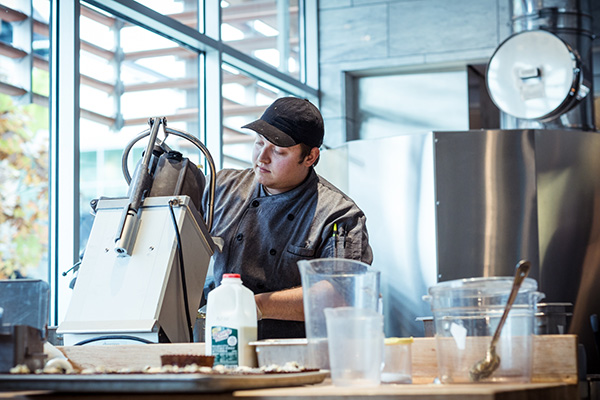Understanding and Lowering the Total Cost of Ownership of Food Prep Equipment

Dollars are precious for any restaurant. Budgets need to cover labor costs, inventory, operating expenses, rent or mortgage and more, including food prep equipment. Understanding if this equipment saves time and money equates to real dollars going in or out of a restaurant. That's why it's important to gain labor savings with the right mixers, slicers and food processors. This equipment can free up employees' time to take on other tasks besides prepping. And it can help lower food costs since it provides consistent results - that improves guests' experience and the bottom line.
When looking for the right food prep equipment, it's important to consider the total cost of ownership or TCO of each machine. This takes into account several factors:
- The equipment's initial price
- Labor savings compared to manually prepping food
- Food cost and volume or usage
- Maintenance and repair
- Downtime for broken equipment
- Expected life span
- Warranty
Employee fatigue and potential workmen's comp are also considered as part of the equipment's TCO. For example, manual food processing at high volumes can cause repetitive stress injuries that can lead to the need and expense for time off. Using food prep equipment can eliminate that issue.
So, what should restaurant owners and chefs look for in food prep equipment to lower the TCO? In short, machines that maximize efficiency and increase profit. In this case, cheaper isn't better. Less expensive equipment typically requires more repairs and needs to be replaced sooner.
Purchasing higher quality equipment can provide a better TCO and a faster return on investment (ROI). There are several features to look for in this equipment, as well as considering the impact of training on lowering TCO.
Training is key when introducing a new piece of equipment into a restaurant kitchen. Ultimately, if employees don't receive the proper training, the anticipated or established savings may not be fully met. Food waste or loss may occur due to improper use of for intended application.
Improving slicer TCO
Having a high-quality slicer can lower the TCO of this equipment. While the life of a slicer depends on the volume and product being sliced, as well as how well it is cared for, a premium machine should last upwards of seven to ten years. That's compared to only a few years for a lower quality one.
Proper cleaning after use is key to increasing longevity, as is proper maintenance. It's important to sharpen the blade regularly to maintain yield and slice quality. Over time, due to sharpening, the blade will naturally need to be replaced. A service technician will need to manage this maintenance.
There are several slicer features that can help lower TCO. One with a stainless steel, cobalt-edge blade can provide a cleaner cut and slice more product with less waste compared to a blade made of carbon steel. This type of blade tends to maintain its sharp edge for longer, so there is less downtime for sharpening. A slicer with a removable blade and other components expedites cleaning, allowing employees to complete the job faster so they can spend more time focused on other tasks. That helps reduce labor costs and ties into reducing TCO of the machine.
Understanding food processor TCO
A premium continuous-feed food processor can make a big difference in the efficiency of food prep and lower TCO over the life of the machine. Continuous-feed food processors are ideal for slicing, dicing and julienne cutting fruits and vegetables and for shredding or grating cheeses.
Like slicers, a quality, a properly cared for food processor can last around seven to ten years. The product being processed and the duration of processing per day factors into its longevity.
Also, like slicers, continuous-feed food processor blades dull over time. Owners and chefs can minimize that replacement frequency by investing in a food processor with a replaceable knife on the stainless-steel cutting tools. It is less expensive to change the knife on a cutting tool compared to replacing the whole tool.
Keeping the food processor clean and free of debris also supports a longer product life. Chefs should be sure to follow proper cleaning instructions for the dicing grid, if used. Don't waste the residual food product left behind in the grid, as that saves money and impacts TCO through a better yield.
The quality and consistency provided by a continuous-feed food processor also impacts the TCO of the machine. For example, if the chef can get eight slices of consistent thickness from a medium sized tomato using the food processor, they can gain a deeper understanding of a sandwich cost and manage inventory better. If sliced by hand, that same tomato may yield seven slices one day and 10 the next, making it difficult to control costs.
So, how much labor savings can they expect compared to manual prep? It can be significant.
Consider a continuous-feed food processor capable of processing 17 pounds of product per minute. If a chef and his kitchen staff dice (10x10 mm or 3/8 inch) 50 pounds of potatoes per day, five days a week (250 days a year) at a labor rate of $15 per hour, this food processor will save 68 hours per month compared to manual cutting. Not only does this provide a short ROI, but it also reduces labor costs.
Lowering mixer TCO
A mixer can be an invaluable part of a busy kitchen, allowing chefs to mix up everything from mashed potatoes to bread dough and cake batter.
If a chef and the kitchen staff operate the mixer properly, taking care not to exceed its mixing capacity, the machine will require minimal maintenance. Equipment life again depends on what is being mixed and for how long each day, but restaurant owners and chefs can expect upwards of 15 years for a premium mixer.
To realize a positive TCO for this type of mixer, look for one that provides a gentle incorporation of ingredients before the transition to speed one. When making dough that's where thorough mixing and gluten development take place. Mixers with a timer that remembers both the time and speed saves time and guesswork, helping to improve productivity. These timers can also count up, which simplifies recipe development, again saving time. And mixers are simply faster than mixing by hand, which is common in many pizza restaurants, for example. They can save labor and reduce user fatigue. What might take 20 minutes to mix by hand, could be done in eight to nine minutes in a mixer and with increased volume.
Caring for a mixer properly can also help it last longer. Keeping it clean is critical. Flour dust, for example, can get into many places, and this includes the mixer itself. Wipe the mixer down thoroughly with a damp cloth after every use. Be sure to coat the mixer with food grade oil after cleaning to reduce the risk of rust forming.
The benefit of looking at TCO
By understanding the factors involved with TCO of food prep equipment, it's easier to help lower it and gain a better ROI. From reducing labor and food costs to increasing the life of the equipment, every bit counts. Gaining consistency and quality also improves overall guest satisfaction, making for return business and a better bottom line.
 Carolyn Bilger is the Marketing Director for Hobart - Food Preparation Products. She has been with Hobart since 2015 and sets the strategy for marketing and new product development for the full line of Hobart food preparation equipment.
Carolyn Bilger is the Marketing Director for Hobart - Food Preparation Products. She has been with Hobart since 2015 and sets the strategy for marketing and new product development for the full line of Hobart food preparation equipment.


